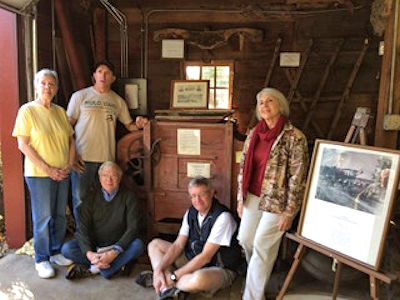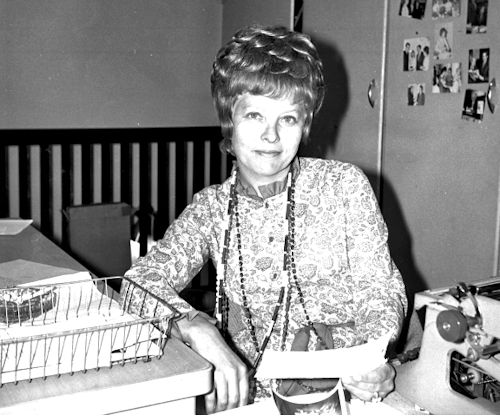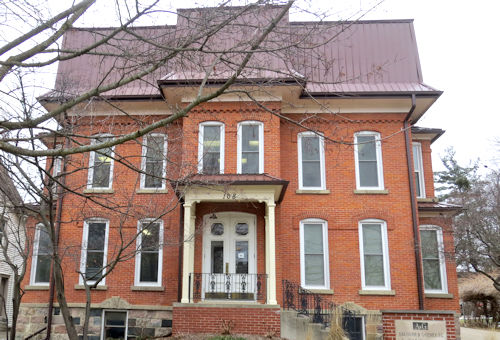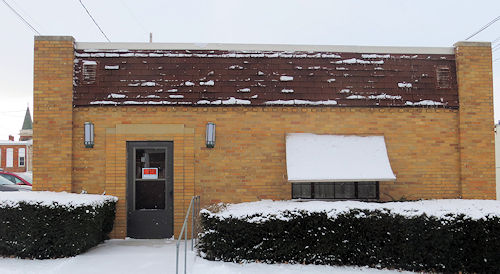St. Johns Heritage Rediscovered
courtesy of Paul Dexter
As we approached St. Johns on Highway 27 in our rented Chevy Suburban, my four siblings and I remembered similar road trips from our childhood more than 60 years earlier. Back then as youngsters, we drove with our grandmother, “Granny” Ms. Robert Chauncey Dexter, from Kalamazoo to visit our great aunt, “Auntie Y” Ms. Florence Jeannette Dexter, then still living in her parents’ stately brick home at 200 Church Street, now the residence of Mr. Jon Rise. We remembered eagerly anticipating Auntie Y’s offering of piping hot Constant Comment tea with cookies, while listening to her and Granny tell stories about our St. Johns ancestors and her beloved parents, Roswell Chauncey Dexter (1859-1936) and Jeannette Paine Davies Dexter (1862-1953). R.C. Dexter was the President of the St. Johns National Bank, and his reputation as “The Dean of St. Johns Bankers” always influenced our upbringing. He was also the Senior Warden of St. Johns Episcopal Church.
This Dexter sibling road trip finally came together last summer after much juggling of busy work schedules and making flight arrangements as far away as Hawaii and Jakarta, Indonesia. Our Dexter family is widely dispersed across the world, and after our father, John Roswell Dexter (1920-2016 and the last of his generation in our family), passed away two weeks shy of his 95th birthday in December 2016, we all felt a need to reconnect with our Michigan roots. Thus we flew to Ann Arbor this fall to spread Dad’s cremated remains over Mom’s grave there and to visit our cousin Julie. We then rented a large enough vehicle to carry us and our luggage and drove to Kalamazoo to spread the rest of his remains over his parent’s graves. There strangers willingly pointed us to where we could find Grandpa Dexter’s downtown bank vault and our great uncle Ellis’ sidewalk clock on which is cast my younger brother’s middle name. Then to Grand Rapids to see the older sibling’s elementary school and Dad’s first church as organist, and finally into St. Johns to see again our Dexter and Davies ancestor’s homes, graves in the Eureka and Mount Rest Cemeteries, and churches, St. Johns Episcopal and the former Greenbush United Methodist.

So it was on a perfect fall Saturday, October 21, 2017, that we arrived at the front door of the Paine-Gillam-Scott Museum where we were warmly greeted by Jan Upton, a volunteer. She had kindly offered to open the museum especially for our visit. We also met Judy Hubler and several other local historian volunteers. All generously shared their knowledge of our Dexter and Davies ancestors and even showed us documents relating to those ancestors researched just for us. They showed us an original Davies fanning mill (a large wooden contraption that separates hulls from seeds) and a milk safe, a large wooden cupboard that kept milk cool. Both are preserved by the museum and we felt very lucky to see them. This museum does a fine job through its many exhibits showing what regular life was like in St. Johns 100+ years ago. Our visit exceeded every expectation and I think our gracious hosts were pleased to have guests with genuine family heritage interests.
We also stopped briefly to again view Auntie Y’s home, still so lovingly preserved by the Rise family, and also to briefly see the former carriage house next door at 204 Church Street, where our Great Grandmother Jeannette lived out her last years. The younger generation of that day was fascinated by her long “hearing trumpet” as Dad and Auntie Y used to tell us. Longtime homeowners there, Barbara and Cayle Beagle, greeted me and then without hesitation, offered a gift of an ancient red elephant crafted of wood and an 1890ish photograph showing Auntie Y as a small child clutching that obviously precious toy. This was a totally unexpected surprise, and I pledged to cherish the heirloom and keep it in the Dexter family. Such wonderful spontaneous generosity!
Our Davies ancestor was Great Grandmother Jeannette, who married William T. Davies on September 22, 1856. Their story reflects the hard work, integrity and strong family orientation — five Davies families settled in Greenbush Township — that was so typical of St. Johns area pioneers. Along with clearing and farming more than 300 acres in Greenbush Township, William T. and his brother Robert E. started a prosperous factory in 1855. They initially partnered with expert cabinet maker and neighbor, David Sevy (another Greenbush Township pioneer), and manufactured fanning mills and milk safes for many years on their property, selling them directly throughout the region. The Davies employed 14 factory workers by 1880, donated the land for the now former Greenbush United Methodist Church in 1898, served as various town officials and contributed liberally to the church and the life of the community.
We then visited the North Scott Road home of David and Judy Hubler which was built in 1874 by William T. Davies. The Hublers have restored and preserved most of the original features of this beautiful house and they explained how it has changed over the decades. They discovered a painted decoration on the original front door and significantly modernized the energy systems of the house. They also rebuilt the original Greenbush Fanning Mill factory building and let us turn the crank on another original, but still functioning, Davies fanning mill. Their commitment to historical preservation is impressive and the Hublers also naturally preserve the warmth and welcoming nature of their home just like the Davies established long ago. Stories of large family holiday gatherings in that Davies home are told by Auntie Y in an oral history now preserved by the Clinton County Historical Society and can be found at this link: http://dewittlibrary.org/CCHS/audiofiles.html
Our St. Johns heritage persists in our family names — my older brother’s and my daughter’s middle name is Roswell, my first cousin’s middle name is Davies and several aunts, uncles and cousins carry Davies, William T. and Jeannette in their names. That heritage also persists in our hearts. Each of my siblings and I were truly moved by the generosity and warm hospitality that was so spontaneously offered by so many people we encountered on our road trip. That was especially true in St. Johns. As we departed back to our busy lives (business executive and musician in HI, music teacher in Jakarta, professional string quartet musician in NYC, singer in MA, and busy volunteer musician in WI), we felt, and we continue to feel, grateful and deeply privileged to have such wonderful St. Johns Heritage. We thank everyone who made that possible.
We Must Take Action
courtesy of Kelly L. Schafer, M.S., Executive Director, The Voice For Clinton County’s Children
 Attention to sexual assault is prevalent now in the National news, but victim’s experiences are not new. These crimes happen right here in our communities, even to our youngest residents—the most vulnerable among us—and are often inflicted by those they know and trust most. The Voice for Clinton County’s Children provides services to these young victims of abuse. We administer two very important programs that support abused and neglected kids in Clinton County.
Attention to sexual assault is prevalent now in the National news, but victim’s experiences are not new. These crimes happen right here in our communities, even to our youngest residents—the most vulnerable among us—and are often inflicted by those they know and trust most. The Voice for Clinton County’s Children provides services to these young victims of abuse. We administer two very important programs that support abused and neglected kids in Clinton County.
Court Appointed Special Advocates (CASA), are specially-trained volunteer citizens from all walks of life who are assigned, by a judge, to a child who has entered the foster care system. Each volunteer gets to know their assigned child through regular visits to develop a trusting relationship, and to make sure no aspect of the child’s experience is overlooked or disregarded. CASA volunteers may be the only consistent adult a child knows while in the foster care system.
In one case, after quite some time of being in the system, a young lady disclosed she had been raped beginning at a very young age by multiple perpetrators. While true-to-life stories like this are difficult to hear, a CASA advocate stood beside this young lady who was brave and strong enough to open up and tell her story. There are many children like this, who could benefit greatly from having a CASA volunteer advocate beside them. It is our dream to have enough volunteers so all children who enter foster care in Clinton County can be appointed a CASA advocate.
The Voice for Clinton County’s Children Child Advocacy Center (CAC) ensures children are not further victimized by the judicial system designed to protect them. The CAC provides a safe, child-friendly place for children to share their stories of sexual and/or physical abuse, and brings together representatives from county service agencies who work together regarding the legal investigation, treatment and potential prosecution of child abuse cases.
CACs provide so many benefits such as more immediate follow-up to child abuse reports, more efficient medical and mental health referrals, increased successful prosecutions, and consistent support for victims and their families.
We have designed our new CAC facility to be welcoming with colorful murals painted throughout. The walls of the interview room have heard detailed accounts of sexual and physical abuse, and will hear more as time goes on, but as one young person said, “It’s not so scary in here.” This feedback is a reflection of great planning and intention—that we are providing a place for abused children to be heard, encouraged, protected, and for kids to know their story matters. As challenging as it may be for us to hear, if a child is strong enough to tell their story of abuse, we must be able to hear it and provide necessary response and support.
While we see the national news a trend to support victims of sexual assault and abuse, it is not enough to just give a moving speech and be part of a public display of unity. We must also act to support victims and allow them to speak out without fear, be supported, and for perpetrators to be held accountable. The Voice for Clinton County’s Children is doing this for children in our community with our CASA and CAC programs.
We invite you to contact us to learn how you can take action to help our valuable mission. Any support you give matters: volunteer, donate, spread the word, and support victims of abuse. Visit our website at VoiceForClintonCountyChildren.org, or call 989-640-5681 to learn more. Together we must act to protect Clinton County’s children.
A Look Back – Annette White
by Barry Clark Bauer

It’s my understanding that Annette White worked on the society section of the Clinton County News. That’s something we don’t see anymore.
She was the wife of Brandon White, banker, and mother of Brandon White II.
Maralyn’s Pet Corner – Canine Influenza Vaccination: Does Your Dog Need It?
Living in the where we do, there are those of us that dread the snow, ice and frigid temperatures while others can’t wait to frolic in the fresh powder or bundle up for some sledding. We will remain split down the middle on that debate, but one thing we all can agree on is that there is nothing worse than flu season.
As humans, we’re fortunate enough that the flu is generally limited to a season. Our canine friends, however, are not so lucky. Canine Influenza (or dog flu) is a highly contagious disease that is a threat all year round.
What is Dog Flu and Where Did It Come From?
There are two identified strains of influenza virus that can affect our dogs and are classified as H3N8 and H3N2. The first recognized outbreak of the H3N8 strain of canine influenza occurred in January 2004 at a greyhound race track in Florida. There have been reported cases in a total of 11 states in the U.S., but only among dogs in race track facilities.
The H3N2 virus was first identified in Asia in 2006. There is no evidence to confirm, but it is suspected that in 2015 the H3N2 strain was introduced to the United States by dogs that were rescued and imported from Asia. This U.S. introduction occurred in Chicago when several dogs at a boarding facility became ill. The company quickly shut down multiple Chicago locations for disinfection, but not before the city experienced the worst outbreak in 35 years. At that time there were over 1,000 cases of infectious respiratory disease reported. From there the H3N2 virus spread through the Midwest and continued to stretch throughout the country.
Do I Need to Worry About Dog Flu?
Canine influenza is transmitted from dog to dog by respiratory secretions (i.e. coughing, sneezing, and barking). The virus can live on surfaces for up to 48 hours, so dogs can pick up the virus from kennel surfaces, water and food bowls, collars, leashes, etc. The virus can live on clothing for 24 hours and on human hands for 12 hours, so people can also carry the virus from infected dogs to uninfected dogs. All dogs are susceptible to the virus at any time but dogs in restricted spaces (like shelters, boarding kennels, day care, etc.) are at a much higher risk.
Symptoms of Dog Flu
Dogs infected with the virus will show symptoms two to three days after being exposed. They will have a cough that can present as a moist, soft cough or a dry hacking cough that can persist for anywhere from 10 to 21 days. The cough can be accompanied by discharge from the eyes and nose, sneezing, lethargy (decrease in activity), decrease in appetite and fever. Dogs with a weaker immune system (young puppies, geriatric dogs or dogs with complicated medical histories) can be more severely affected and present with symptoms of pneumonia (high-grade fever, increased respiratory rate and labored breathing).
Because these symptoms are the same as any number of respiratory infections, canine influenza cannot be diagnosed on symptoms alone. There are tests that can be preformed to confirm the diagnosis. Because the cough can persist for up to 21 days, a 21-day quarantine is recommended for infected dogs.
Treatment can include fluids to maintain hydration, anti-inflammatory medications for fever reduction and discomfort and antibiotics for any suspected secondary bacterial infections are used to support the dog’s health until the virus is fought off by the body’s immune system.
Should You Vaccinate Against Canine Flu?
If your dog needs to be taken to boarding, grooming, or daycare facility, be an advocate for him. Make sure these facilities follow a strict cleaning regiment and schedule using proper disinfecting products and that the personnel are appropriately trained to understand cross contamination and how to prevent it. Lastly, finding a facility that requires all dogs to be vaccinated before entering their facility will also help protect your dog.
Dogs that are at higher risk of exposure should be vaccinated. The first canine influenza vaccine was introduced in June of 2009 to aid in controlling infection with canine influenza virus H3N8, since that was the only strain found in the United States at that time. In 2015, following the Chicago epidemic, Merck Animal Health announced the availability of an H3N2 vaccine. Now that both strains have been identified in the U.S. and the occurrence of one strain or the other is unpredictable, it was recommended that high-risk dogs should be protected against both strains of the virus.
In October, a vaccine was introduced to aid in the control of infection with both strains of the virus. Healthy dogs seven weeks of age or older can be given the vaccine, which requires two vaccinations given two-to-four weeks apart. Initial studies have shown that dogs do not maintain long duration of immunity so it is important to revaccinate them annually.
Although the dog flu has been reported in 40 states (including Washington DC), the vaccine has not become a requirement in all high-risk facilities. In general, only those that have had reported cases of flu in their facility or city feel compelled to require it. Because of this, not all veterinarians are keeping the vaccine in stock. If you have decided to protect your dog using the canine influenza vaccine, be sure to speak to your veterinarian so they can order it for you if they don’t normally stock it. To ensure that your dog is receiving the vaccine’s full protection, it should be given at least two weeks prior to possible exposure.
We as pet parents do need to understand, however, that vaccinated dogs can still become infected and develop the illness. The purpose of the vaccination is to control the spread of the disease by reducing the severity and duration of illness and symptoms, reduce the amount of virus that is shed by infected dogs and how long they shed the virus.
If you have more questions about dog flu, are uncertain if your dog is at risk or wonder if the vaccination is needed/appropriate for your four-legged friend, please have a conversation with your veterinarian. They will help you decide the best way to protect your best friend.
Remember When? – Dr. Luton’s office
by Maralyn Fink

The old Hart Hospital located at 108 Spring St., is where I had my tonsils out in the 1940s. I remember how scared I was and laying on the table. A few words of encouragement from Dr. Frank Luton sort of helped calm me down. The next thing I saw was someone with a wet rag and placing it over my nose that had an awful smell to it. I woke up and remember how sick I got from that stuff called Ether. The nice thing was all the popsicles I got to eat.

Dr. Luton later built a new clinic across Spring Street where he had his office until his retirement. Dr. Wholers later had his dentist office there.